Tesco's Quality Management: Process Improvement and Analysis Report
VerifiedAdded on 2023/01/13
|19
|4498
|79
Report
AI Summary
This report provides a detailed analysis of Tesco's quality management practices, focusing on process improvement within the production department. It identifies key issues such as rising raw material costs, product failure, and the need for skilled labor. The report utilizes tools like the Fishbone diagram and Pareto chart to diagnose the root causes of these problems. Proposed solutions include reviewing testing procedures, improving supplier relationships, and investing in employee training and development. An implementation plan with timelines and resource requirements is also presented. The report concludes with a discussion of quality and quality management, referencing Deming's 14 points for Total Quality Management (TQM) and its application to Tesco's operations, highlighting the evolution of quality management principles and their impact on business success, particularly in the context of the Japanese industrial landscape and Toyota's implementation of the Kanban system and Just-in-Time inventory procedures. The report emphasizes the importance of long-term customer satisfaction and stakeholder collaboration for organizational success.
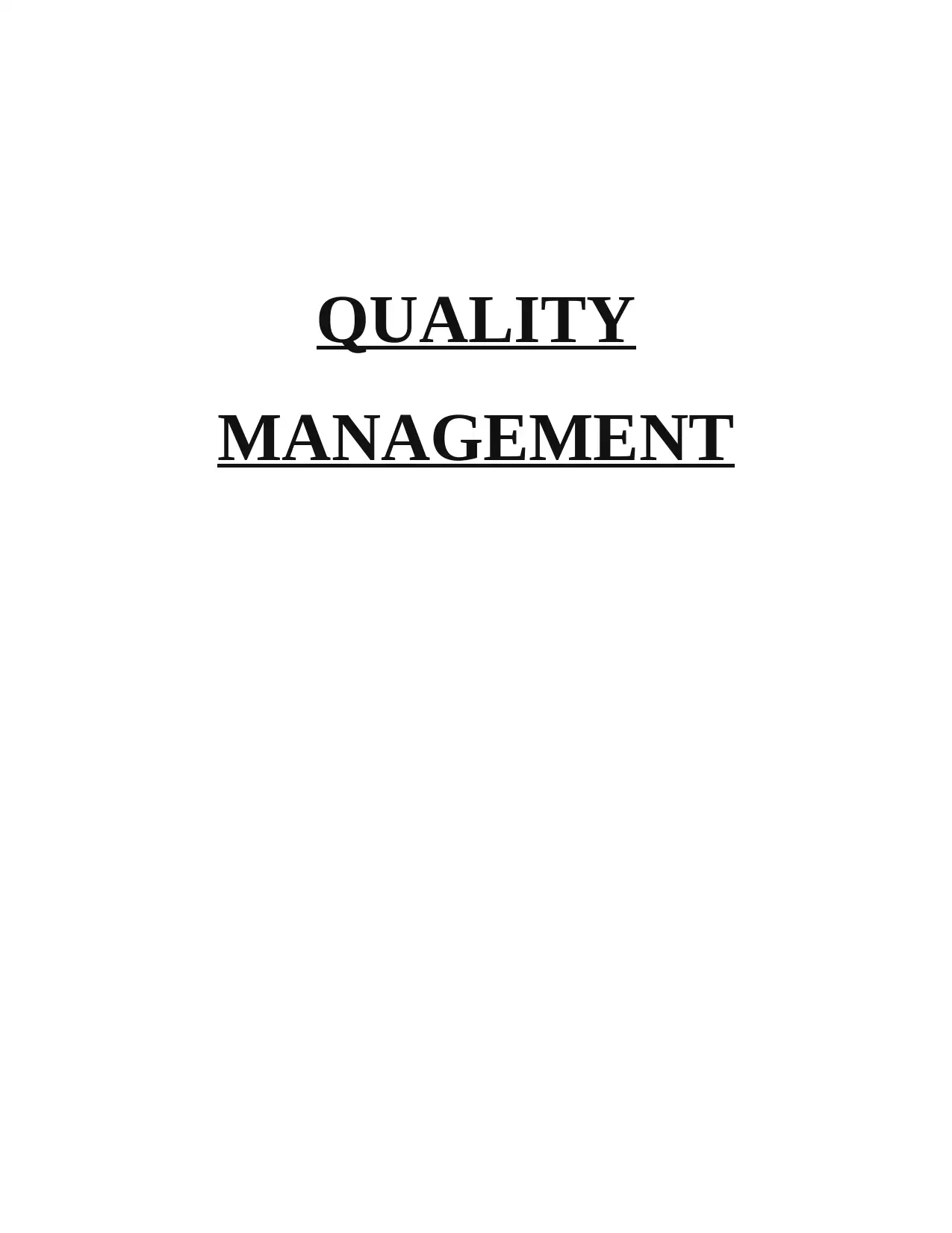
QUALITY
MANAGEMENT
MANAGEMENT
Paraphrase This Document
Need a fresh take? Get an instant paraphrase of this document with our AI Paraphraser

Table of Contents
INTRODUCTION...........................................................................................................................3
MAIN BODY...................................................................................................................................3
1. Define process improvement for organisation department..........................................................3
a. Description on organisation, department and process..............................................................3
b. The existing problem and opportunity identified.....................................................................3
c. Proposed solutions...................................................................................................................5
d. Implementation of plan............................................................................................................7
What is Quality and Quality Management-.................................................................................8
Assessing an organization across Deming's 14 points for Total Quality Management-...........10
CONCLUSION .............................................................................................................................17
REFERENCES..............................................................................................................................18
INTRODUCTION...........................................................................................................................3
MAIN BODY...................................................................................................................................3
1. Define process improvement for organisation department..........................................................3
a. Description on organisation, department and process..............................................................3
b. The existing problem and opportunity identified.....................................................................3
c. Proposed solutions...................................................................................................................5
d. Implementation of plan............................................................................................................7
What is Quality and Quality Management-.................................................................................8
Assessing an organization across Deming's 14 points for Total Quality Management-...........10
CONCLUSION .............................................................................................................................17
REFERENCES..............................................................................................................................18
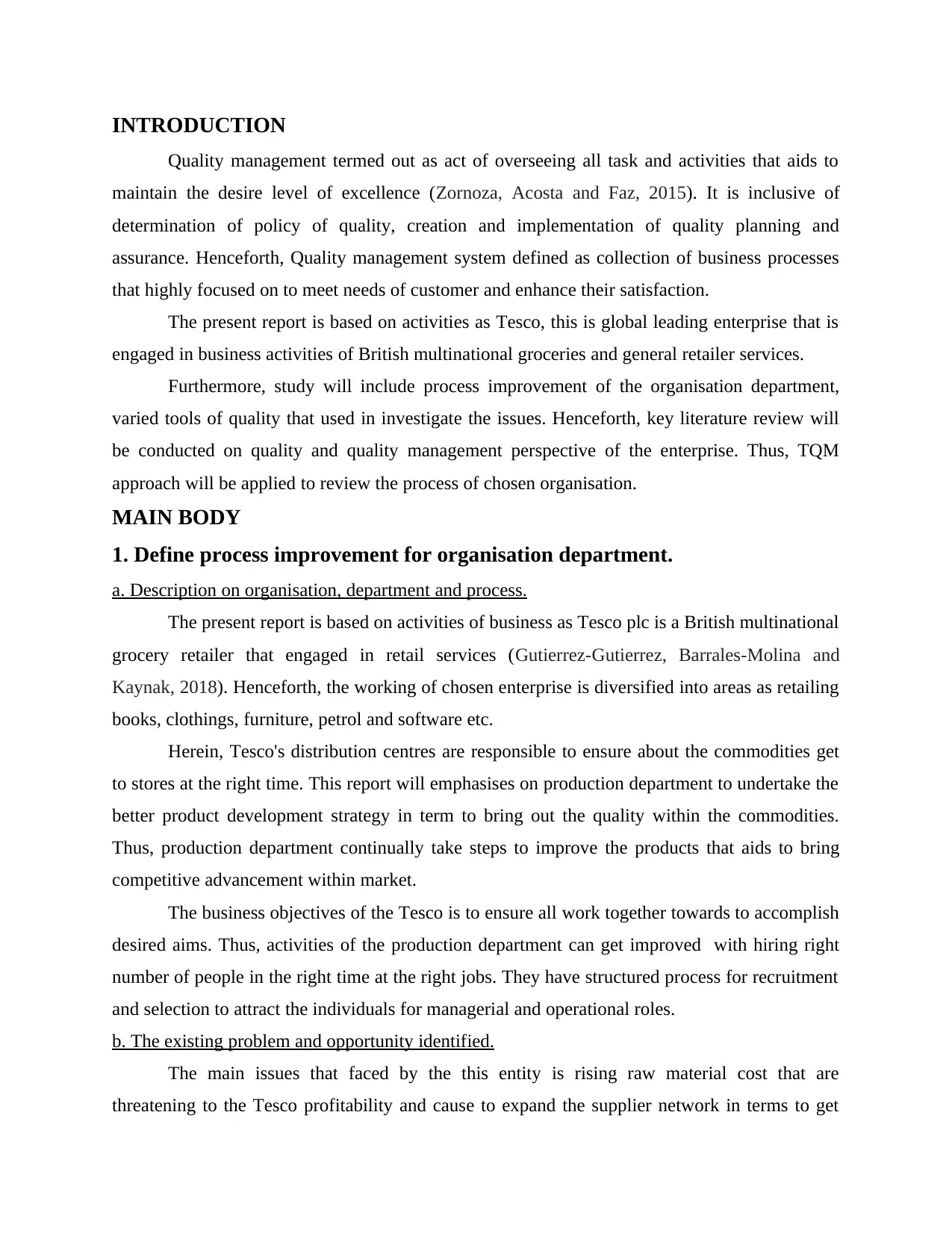
INTRODUCTION
Quality management termed out as act of overseeing all task and activities that aids to
maintain the desire level of excellence (Zornoza, Acosta and Faz, 2015). It is inclusive of
determination of policy of quality, creation and implementation of quality planning and
assurance. Henceforth, Quality management system defined as collection of business processes
that highly focused on to meet needs of customer and enhance their satisfaction.
The present report is based on activities as Tesco, this is global leading enterprise that is
engaged in business activities of British multinational groceries and general retailer services.
Furthermore, study will include process improvement of the organisation department,
varied tools of quality that used in investigate the issues. Henceforth, key literature review will
be conducted on quality and quality management perspective of the enterprise. Thus, TQM
approach will be applied to review the process of chosen organisation.
MAIN BODY
1. Define process improvement for organisation department.
a. Description on organisation, department and process.
The present report is based on activities of business as Tesco plc is a British multinational
grocery retailer that engaged in retail services (Gutierrez-Gutierrez, Barrales-Molina and
Kaynak, 2018). Henceforth, the working of chosen enterprise is diversified into areas as retailing
books, clothings, furniture, petrol and software etc.
Herein, Tesco's distribution centres are responsible to ensure about the commodities get
to stores at the right time. This report will emphasises on production department to undertake the
better product development strategy in term to bring out the quality within the commodities.
Thus, production department continually take steps to improve the products that aids to bring
competitive advancement within market.
The business objectives of the Tesco is to ensure all work together towards to accomplish
desired aims. Thus, activities of the production department can get improved with hiring right
number of people in the right time at the right jobs. They have structured process for recruitment
and selection to attract the individuals for managerial and operational roles.
b. The existing problem and opportunity identified.
The main issues that faced by the this entity is rising raw material cost that are
threatening to the Tesco profitability and cause to expand the supplier network in terms to get
Quality management termed out as act of overseeing all task and activities that aids to
maintain the desire level of excellence (Zornoza, Acosta and Faz, 2015). It is inclusive of
determination of policy of quality, creation and implementation of quality planning and
assurance. Henceforth, Quality management system defined as collection of business processes
that highly focused on to meet needs of customer and enhance their satisfaction.
The present report is based on activities as Tesco, this is global leading enterprise that is
engaged in business activities of British multinational groceries and general retailer services.
Furthermore, study will include process improvement of the organisation department,
varied tools of quality that used in investigate the issues. Henceforth, key literature review will
be conducted on quality and quality management perspective of the enterprise. Thus, TQM
approach will be applied to review the process of chosen organisation.
MAIN BODY
1. Define process improvement for organisation department.
a. Description on organisation, department and process.
The present report is based on activities of business as Tesco plc is a British multinational
grocery retailer that engaged in retail services (Gutierrez-Gutierrez, Barrales-Molina and
Kaynak, 2018). Henceforth, the working of chosen enterprise is diversified into areas as retailing
books, clothings, furniture, petrol and software etc.
Herein, Tesco's distribution centres are responsible to ensure about the commodities get
to stores at the right time. This report will emphasises on production department to undertake the
better product development strategy in term to bring out the quality within the commodities.
Thus, production department continually take steps to improve the products that aids to bring
competitive advancement within market.
The business objectives of the Tesco is to ensure all work together towards to accomplish
desired aims. Thus, activities of the production department can get improved with hiring right
number of people in the right time at the right jobs. They have structured process for recruitment
and selection to attract the individuals for managerial and operational roles.
b. The existing problem and opportunity identified.
The main issues that faced by the this entity is rising raw material cost that are
threatening to the Tesco profitability and cause to expand the supplier network in terms to get
⊘ This is a preview!⊘
Do you want full access?
Subscribe today to unlock all pages.

Trusted by 1+ million students worldwide

effective prices on raw materials. It is entity that is facing competitive threats and to overcome
from it they needs to develop the product development strategy so that effective measures can be
undertake to gain the competitive advancement (Soares, Soltani and Liao, 2017). Thus,
advanced pressure stakeholders in relates with social responsibility and environment adversely
impact Tesco cost basis. Thus, Tesco needs to focus on quality management of the commodities
in terms to deal with rivalries within market.
Fish born diagram-
The fish-bone diagram can be used to identify the problems that exist within the
enterprise. Henceforth, the Tesco is facing the issues as Product failure and Fish-bone technique
will be used to identify the root cause of the issue. Henceforth, these can be applied in following
manner as-:
Define the problem- The problem in this is already defined as Product Failure. Therefore, team
knowns that this issue has been occurred due to issues in production department that link with
continue rising of the raw material cost that affects the profitability and productivity of quoted
enterprise (Obeidat, Hashem and Al-Salti, 2016). Herein, Fish-bone technique has been used to
identify the root-cause of product failure as-
Brainstorm- The team of the enterprise needs to use this method to brainstorm the session that
helps to investigate the root cause of problem. Additionally, the each category and significance
to issue defined as-:
Method- In this the techniques and way of doing things are the major cause that is
causing the possible obstacles. Therefore, the method taken by the authorities can be
ineffective and this can affect the working of enterprise negatively.
Men- In this, it has been identified that the ineffective skills of men are being the cause
of problem (del Alonso-Almeida, Bagur-Femenías and Llach, 2015). Thus, few
experienced authorities handled the production and supply network of raw materials that
bring the major issues within the enterprise.
Management- The management team of the enterprise needs to look forward to hire the
suitable workers that can able to bring out the business activities effectively.
Materials- The raw materials are the resources that can be used to produced the finished
good and products. Therefore, the main cause of the issue is the rising cost of resources
from it they needs to develop the product development strategy so that effective measures can be
undertake to gain the competitive advancement (Soares, Soltani and Liao, 2017). Thus,
advanced pressure stakeholders in relates with social responsibility and environment adversely
impact Tesco cost basis. Thus, Tesco needs to focus on quality management of the commodities
in terms to deal with rivalries within market.
Fish born diagram-
The fish-bone diagram can be used to identify the problems that exist within the
enterprise. Henceforth, the Tesco is facing the issues as Product failure and Fish-bone technique
will be used to identify the root cause of the issue. Henceforth, these can be applied in following
manner as-:
Define the problem- The problem in this is already defined as Product Failure. Therefore, team
knowns that this issue has been occurred due to issues in production department that link with
continue rising of the raw material cost that affects the profitability and productivity of quoted
enterprise (Obeidat, Hashem and Al-Salti, 2016). Herein, Fish-bone technique has been used to
identify the root-cause of product failure as-
Brainstorm- The team of the enterprise needs to use this method to brainstorm the session that
helps to investigate the root cause of problem. Additionally, the each category and significance
to issue defined as-:
Method- In this the techniques and way of doing things are the major cause that is
causing the possible obstacles. Therefore, the method taken by the authorities can be
ineffective and this can affect the working of enterprise negatively.
Men- In this, it has been identified that the ineffective skills of men are being the cause
of problem (del Alonso-Almeida, Bagur-Femenías and Llach, 2015). Thus, few
experienced authorities handled the production and supply network of raw materials that
bring the major issues within the enterprise.
Management- The management team of the enterprise needs to look forward to hire the
suitable workers that can able to bring out the business activities effectively.
Materials- The raw materials are the resources that can be used to produced the finished
good and products. Therefore, the main cause of the issue is the rising cost of resources
Paraphrase This Document
Need a fresh take? Get an instant paraphrase of this document with our AI Paraphraser
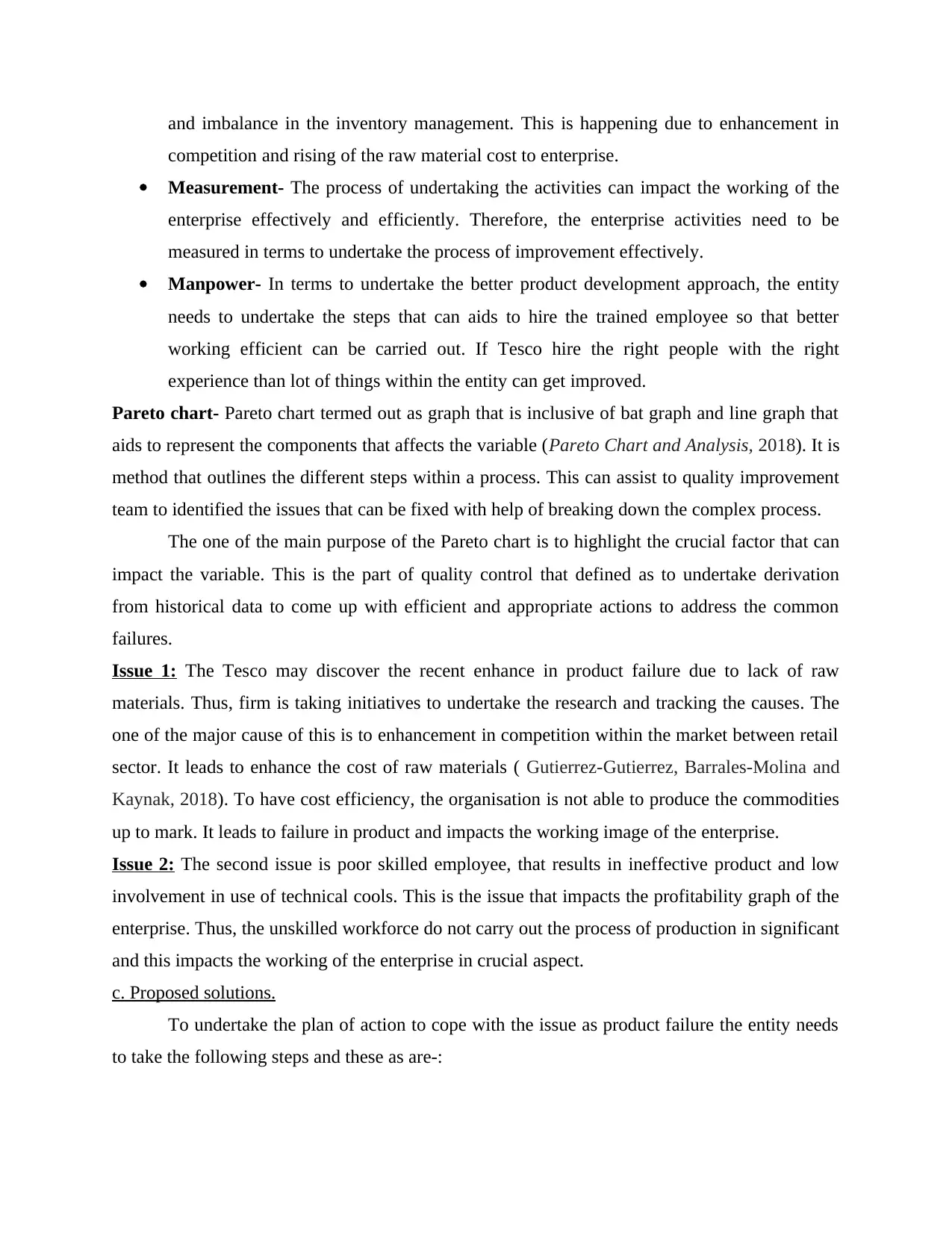
and imbalance in the inventory management. This is happening due to enhancement in
competition and rising of the raw material cost to enterprise.
Measurement- The process of undertaking the activities can impact the working of the
enterprise effectively and efficiently. Therefore, the enterprise activities need to be
measured in terms to undertake the process of improvement effectively.
Manpower- In terms to undertake the better product development approach, the entity
needs to undertake the steps that can aids to hire the trained employee so that better
working efficient can be carried out. If Tesco hire the right people with the right
experience than lot of things within the entity can get improved.
Pareto chart- Pareto chart termed out as graph that is inclusive of bat graph and line graph that
aids to represent the components that affects the variable (Pareto Chart and Analysis, 2018). It is
method that outlines the different steps within a process. This can assist to quality improvement
team to identified the issues that can be fixed with help of breaking down the complex process.
The one of the main purpose of the Pareto chart is to highlight the crucial factor that can
impact the variable. This is the part of quality control that defined as to undertake derivation
from historical data to come up with efficient and appropriate actions to address the common
failures.
Issue 1: The Tesco may discover the recent enhance in product failure due to lack of raw
materials. Thus, firm is taking initiatives to undertake the research and tracking the causes. The
one of the major cause of this is to enhancement in competition within the market between retail
sector. It leads to enhance the cost of raw materials ( Gutierrez-Gutierrez, Barrales-Molina and
Kaynak, 2018). To have cost efficiency, the organisation is not able to produce the commodities
up to mark. It leads to failure in product and impacts the working image of the enterprise.
Issue 2: The second issue is poor skilled employee, that results in ineffective product and low
involvement in use of technical cools. This is the issue that impacts the profitability graph of the
enterprise. Thus, the unskilled workforce do not carry out the process of production in significant
and this impacts the working of the enterprise in crucial aspect.
c. Proposed solutions.
To undertake the plan of action to cope with the issue as product failure the entity needs
to take the following steps and these as are-:
competition and rising of the raw material cost to enterprise.
Measurement- The process of undertaking the activities can impact the working of the
enterprise effectively and efficiently. Therefore, the enterprise activities need to be
measured in terms to undertake the process of improvement effectively.
Manpower- In terms to undertake the better product development approach, the entity
needs to undertake the steps that can aids to hire the trained employee so that better
working efficient can be carried out. If Tesco hire the right people with the right
experience than lot of things within the entity can get improved.
Pareto chart- Pareto chart termed out as graph that is inclusive of bat graph and line graph that
aids to represent the components that affects the variable (Pareto Chart and Analysis, 2018). It is
method that outlines the different steps within a process. This can assist to quality improvement
team to identified the issues that can be fixed with help of breaking down the complex process.
The one of the main purpose of the Pareto chart is to highlight the crucial factor that can
impact the variable. This is the part of quality control that defined as to undertake derivation
from historical data to come up with efficient and appropriate actions to address the common
failures.
Issue 1: The Tesco may discover the recent enhance in product failure due to lack of raw
materials. Thus, firm is taking initiatives to undertake the research and tracking the causes. The
one of the major cause of this is to enhancement in competition within the market between retail
sector. It leads to enhance the cost of raw materials ( Gutierrez-Gutierrez, Barrales-Molina and
Kaynak, 2018). To have cost efficiency, the organisation is not able to produce the commodities
up to mark. It leads to failure in product and impacts the working image of the enterprise.
Issue 2: The second issue is poor skilled employee, that results in ineffective product and low
involvement in use of technical cools. This is the issue that impacts the profitability graph of the
enterprise. Thus, the unskilled workforce do not carry out the process of production in significant
and this impacts the working of the enterprise in crucial aspect.
c. Proposed solutions.
To undertake the plan of action to cope with the issue as product failure the entity needs
to take the following steps and these as are-:

To carry out the process of review of testing approach and procedure by quality
managers. The QA manager of the entity needs taste the quality of raw material and they
must take initiatives to develop better relationship with the suppliers so that high level of
proficiency can be developed.
The managing authorities of the enterprise needs to undertake suitable recruitment and
must full-fill the need of training and development to the new employees (Zornoza,
Acosta and Faz, 2015).
The whole team decided to change the process of product development by developing
better relations with suppliers and hiring the technical skilled labour workforce. It can be
one of the effective way to undertake the managerial working effectively and efficiently.
As per the principle of pareto, Tesco authorities needs to employ the strategies that aids
to accomplish the improvement in product quality by maintaining the better relation with
the suppliers. This can aids to remedied the 20% of the problem and in this way chosen
firm can improve the outcome by 80%.
The chart has been given to identified the cause of product failure as-:
Causes of dissatisfaction % /100
Poor quality 15.00%
Lack of raw material 20.00%
Improper skilled workforce 25.00%
Lack of training and development facilities 30.00%
managers. The QA manager of the entity needs taste the quality of raw material and they
must take initiatives to develop better relationship with the suppliers so that high level of
proficiency can be developed.
The managing authorities of the enterprise needs to undertake suitable recruitment and
must full-fill the need of training and development to the new employees (Zornoza,
Acosta and Faz, 2015).
The whole team decided to change the process of product development by developing
better relations with suppliers and hiring the technical skilled labour workforce. It can be
one of the effective way to undertake the managerial working effectively and efficiently.
As per the principle of pareto, Tesco authorities needs to employ the strategies that aids
to accomplish the improvement in product quality by maintaining the better relation with
the suppliers. This can aids to remedied the 20% of the problem and in this way chosen
firm can improve the outcome by 80%.
The chart has been given to identified the cause of product failure as-:
Causes of dissatisfaction % /100
Poor quality 15.00%
Lack of raw material 20.00%
Improper skilled workforce 25.00%
Lack of training and development facilities 30.00%
⊘ This is a preview!⊘
Do you want full access?
Subscribe today to unlock all pages.

Trusted by 1+ million students worldwide
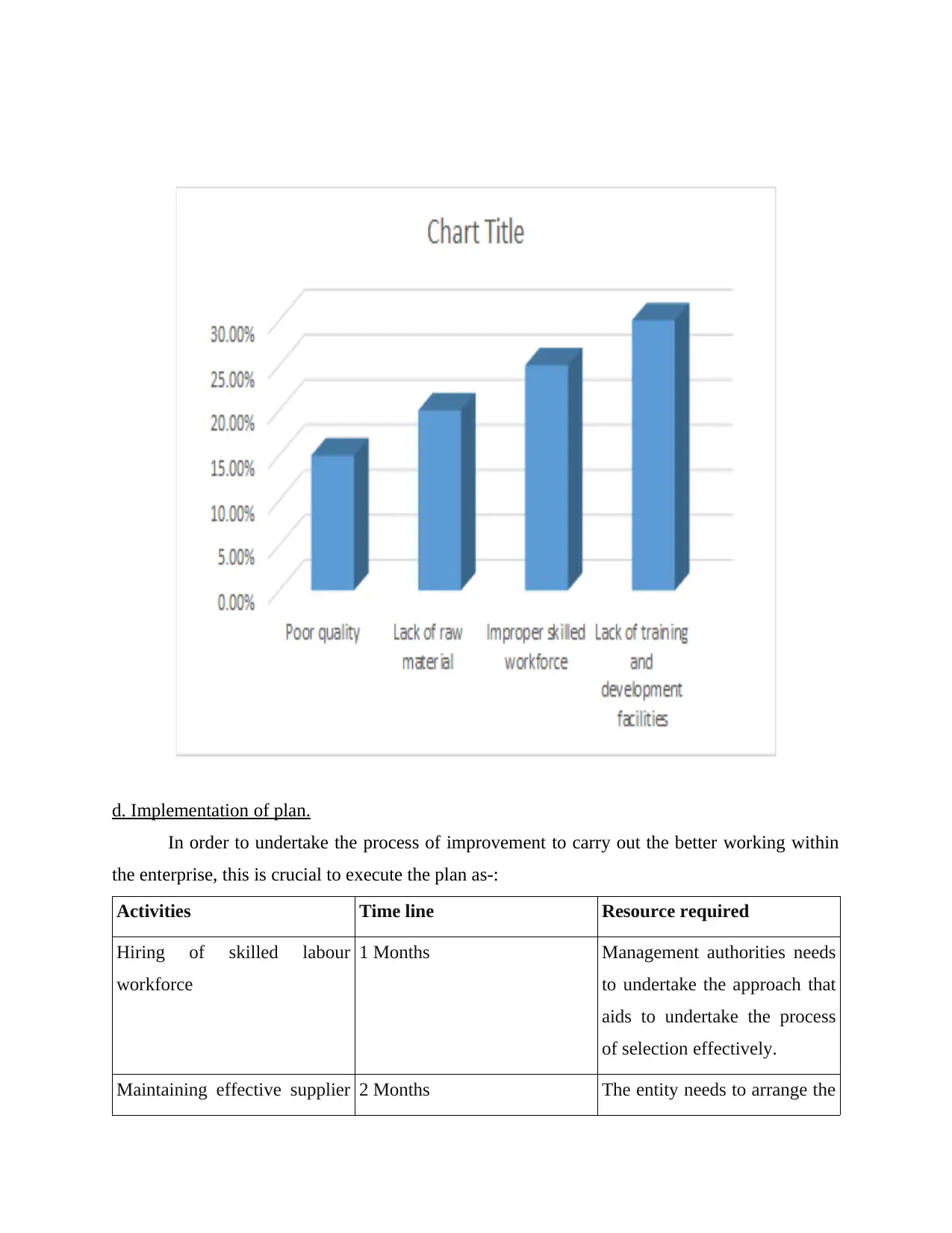
d. Implementation of plan.
In order to undertake the process of improvement to carry out the better working within
the enterprise, this is crucial to execute the plan as-:
Activities Time line Resource required
Hiring of skilled labour
workforce
1 Months Management authorities needs
to undertake the approach that
aids to undertake the process
of selection effectively.
Maintaining effective supplier 2 Months The entity needs to arrange the
In order to undertake the process of improvement to carry out the better working within
the enterprise, this is crucial to execute the plan as-:
Activities Time line Resource required
Hiring of skilled labour
workforce
1 Months Management authorities needs
to undertake the approach that
aids to undertake the process
of selection effectively.
Maintaining effective supplier 2 Months The entity needs to arrange the
Paraphrase This Document
Need a fresh take? Get an instant paraphrase of this document with our AI Paraphraser
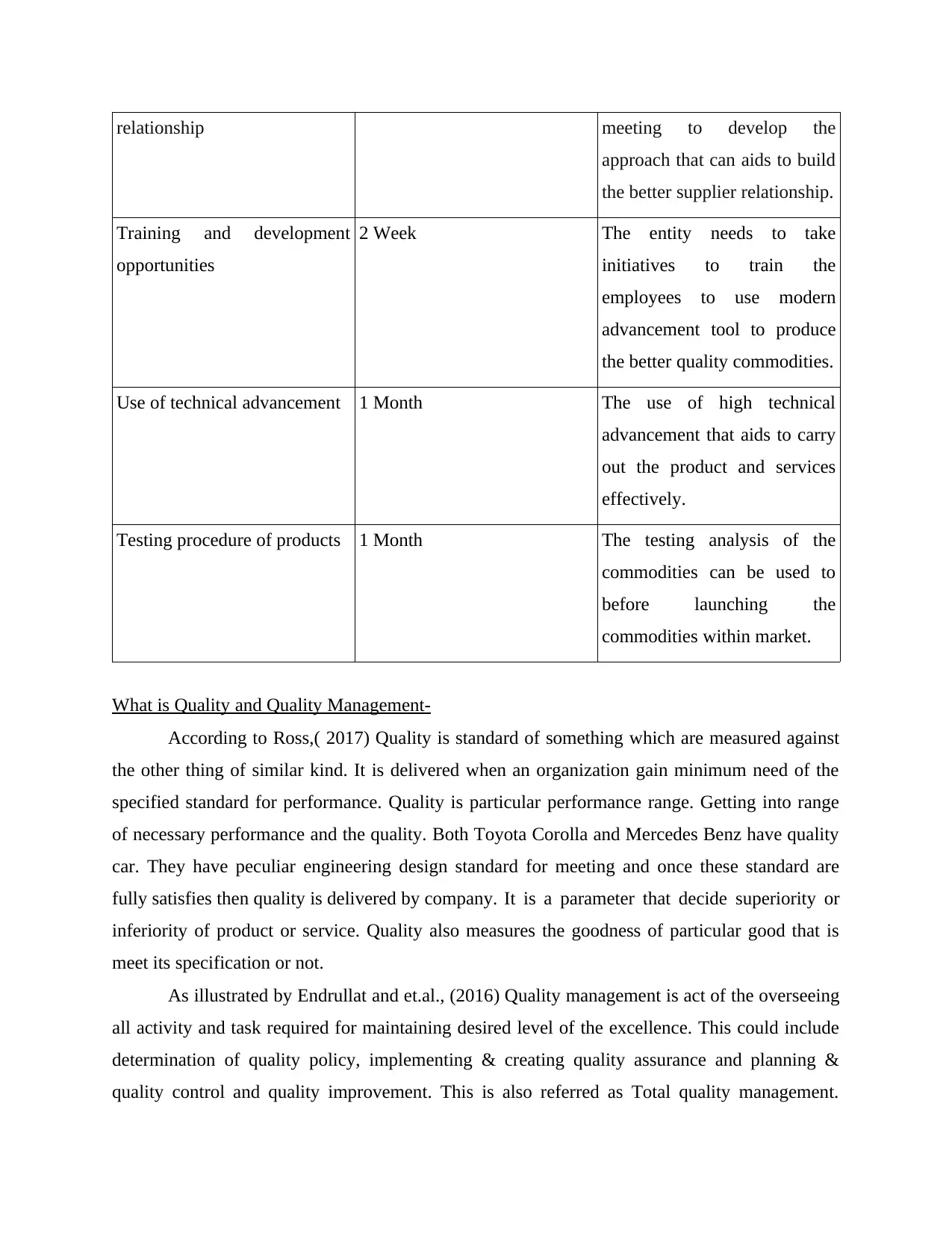
relationship meeting to develop the
approach that can aids to build
the better supplier relationship.
Training and development
opportunities
2 Week The entity needs to take
initiatives to train the
employees to use modern
advancement tool to produce
the better quality commodities.
Use of technical advancement 1 Month The use of high technical
advancement that aids to carry
out the product and services
effectively.
Testing procedure of products 1 Month The testing analysis of the
commodities can be used to
before launching the
commodities within market.
What is Quality and Quality Management-
According to Ross,( 2017) Quality is standard of something which are measured against
the other thing of similar kind. It is delivered when an organization gain minimum need of the
specified standard for performance. Quality is particular performance range. Getting into range
of necessary performance and the quality. Both Toyota Corolla and Mercedes Benz have quality
car. They have peculiar engineering design standard for meeting and once these standard are
fully satisfies then quality is delivered by company. It is a parameter that decide superiority or
inferiority of product or service. Quality also measures the goodness of particular good that is
meet its specification or not.
As illustrated by Endrullat and et.al., (2016) Quality management is act of the overseeing
all activity and task required for maintaining desired level of the excellence. This could include
determination of quality policy, implementing & creating quality assurance and planning &
quality control and quality improvement. This is also referred as Total quality management.
approach that can aids to build
the better supplier relationship.
Training and development
opportunities
2 Week The entity needs to take
initiatives to train the
employees to use modern
advancement tool to produce
the better quality commodities.
Use of technical advancement 1 Month The use of high technical
advancement that aids to carry
out the product and services
effectively.
Testing procedure of products 1 Month The testing analysis of the
commodities can be used to
before launching the
commodities within market.
What is Quality and Quality Management-
According to Ross,( 2017) Quality is standard of something which are measured against
the other thing of similar kind. It is delivered when an organization gain minimum need of the
specified standard for performance. Quality is particular performance range. Getting into range
of necessary performance and the quality. Both Toyota Corolla and Mercedes Benz have quality
car. They have peculiar engineering design standard for meeting and once these standard are
fully satisfies then quality is delivered by company. It is a parameter that decide superiority or
inferiority of product or service. Quality also measures the goodness of particular good that is
meet its specification or not.
As illustrated by Endrullat and et.al., (2016) Quality management is act of the overseeing
all activity and task required for maintaining desired level of the excellence. This could include
determination of quality policy, implementing & creating quality assurance and planning &
quality control and quality improvement. This is also referred as Total quality management.
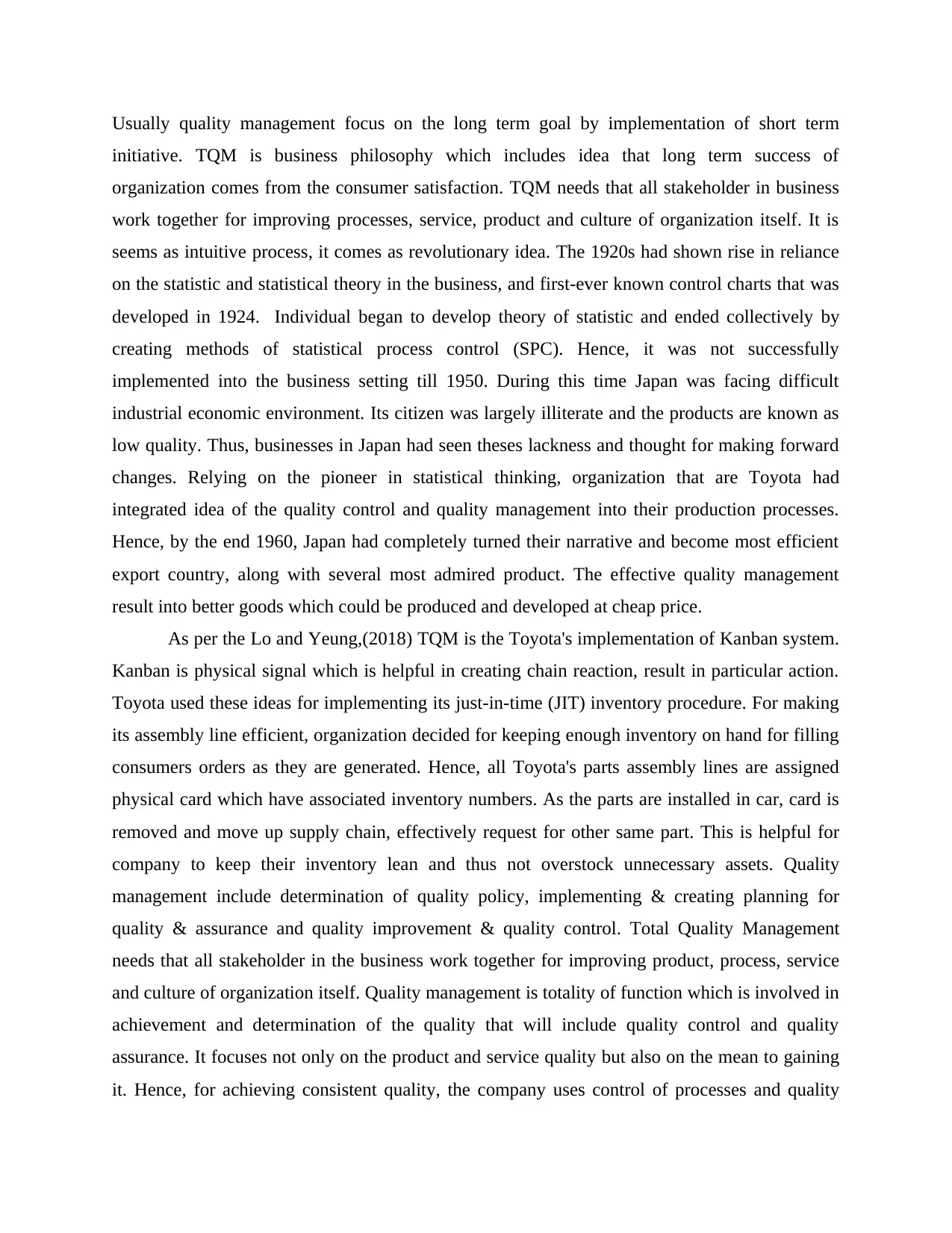
Usually quality management focus on the long term goal by implementation of short term
initiative. TQM is business philosophy which includes idea that long term success of
organization comes from the consumer satisfaction. TQM needs that all stakeholder in business
work together for improving processes, service, product and culture of organization itself. It is
seems as intuitive process, it comes as revolutionary idea. The 1920s had shown rise in reliance
on the statistic and statistical theory in the business, and first-ever known control charts that was
developed in 1924. Individual began to develop theory of statistic and ended collectively by
creating methods of statistical process control (SPC). Hence, it was not successfully
implemented into the business setting till 1950. During this time Japan was facing difficult
industrial economic environment. Its citizen was largely illiterate and the products are known as
low quality. Thus, businesses in Japan had seen theses lackness and thought for making forward
changes. Relying on the pioneer in statistical thinking, organization that are Toyota had
integrated idea of the quality control and quality management into their production processes.
Hence, by the end 1960, Japan had completely turned their narrative and become most efficient
export country, along with several most admired product. The effective quality management
result into better goods which could be produced and developed at cheap price.
As per the Lo and Yeung,(2018) TQM is the Toyota's implementation of Kanban system.
Kanban is physical signal which is helpful in creating chain reaction, result in particular action.
Toyota used these ideas for implementing its just-in-time (JIT) inventory procedure. For making
its assembly line efficient, organization decided for keeping enough inventory on hand for filling
consumers orders as they are generated. Hence, all Toyota's parts assembly lines are assigned
physical card which have associated inventory numbers. As the parts are installed in car, card is
removed and move up supply chain, effectively request for other same part. This is helpful for
company to keep their inventory lean and thus not overstock unnecessary assets. Quality
management include determination of quality policy, implementing & creating planning for
quality & assurance and quality improvement & quality control. Total Quality Management
needs that all stakeholder in the business work together for improving product, process, service
and culture of organization itself. Quality management is totality of function which is involved in
achievement and determination of the quality that will include quality control and quality
assurance. It focuses not only on the product and service quality but also on the mean to gaining
it. Hence, for achieving consistent quality, the company uses control of processes and quality
initiative. TQM is business philosophy which includes idea that long term success of
organization comes from the consumer satisfaction. TQM needs that all stakeholder in business
work together for improving processes, service, product and culture of organization itself. It is
seems as intuitive process, it comes as revolutionary idea. The 1920s had shown rise in reliance
on the statistic and statistical theory in the business, and first-ever known control charts that was
developed in 1924. Individual began to develop theory of statistic and ended collectively by
creating methods of statistical process control (SPC). Hence, it was not successfully
implemented into the business setting till 1950. During this time Japan was facing difficult
industrial economic environment. Its citizen was largely illiterate and the products are known as
low quality. Thus, businesses in Japan had seen theses lackness and thought for making forward
changes. Relying on the pioneer in statistical thinking, organization that are Toyota had
integrated idea of the quality control and quality management into their production processes.
Hence, by the end 1960, Japan had completely turned their narrative and become most efficient
export country, along with several most admired product. The effective quality management
result into better goods which could be produced and developed at cheap price.
As per the Lo and Yeung,(2018) TQM is the Toyota's implementation of Kanban system.
Kanban is physical signal which is helpful in creating chain reaction, result in particular action.
Toyota used these ideas for implementing its just-in-time (JIT) inventory procedure. For making
its assembly line efficient, organization decided for keeping enough inventory on hand for filling
consumers orders as they are generated. Hence, all Toyota's parts assembly lines are assigned
physical card which have associated inventory numbers. As the parts are installed in car, card is
removed and move up supply chain, effectively request for other same part. This is helpful for
company to keep their inventory lean and thus not overstock unnecessary assets. Quality
management include determination of quality policy, implementing & creating planning for
quality & assurance and quality improvement & quality control. Total Quality Management
needs that all stakeholder in the business work together for improving product, process, service
and culture of organization itself. Quality management is totality of function which is involved in
achievement and determination of the quality that will include quality control and quality
assurance. It focuses not only on the product and service quality but also on the mean to gaining
it. Hence, for achieving consistent quality, the company uses control of processes and quality
⊘ This is a preview!⊘
Do you want full access?
Subscribe today to unlock all pages.

Trusted by 1+ million students worldwide
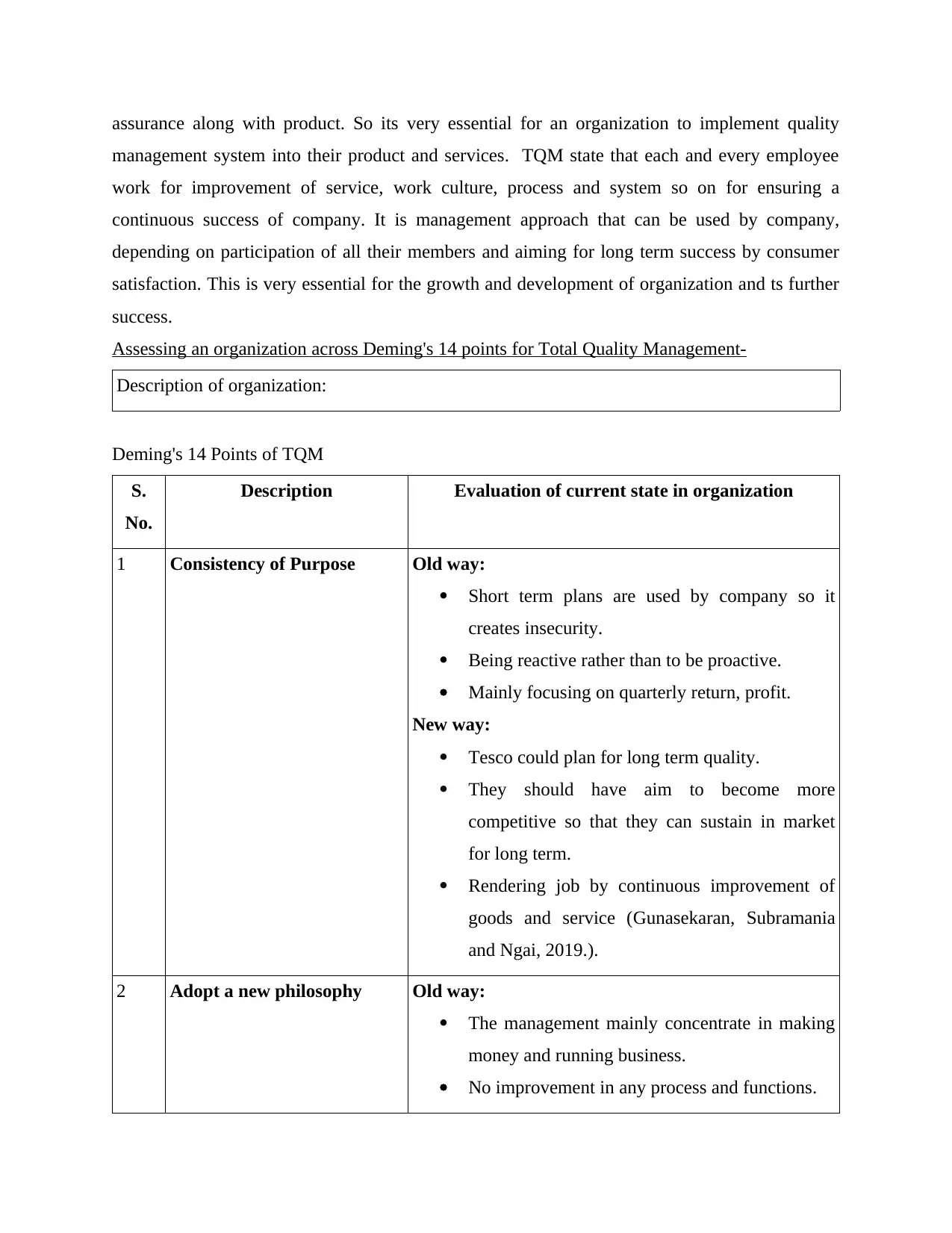
assurance along with product. So its very essential for an organization to implement quality
management system into their product and services. TQM state that each and every employee
work for improvement of service, work culture, process and system so on for ensuring a
continuous success of company. It is management approach that can be used by company,
depending on participation of all their members and aiming for long term success by consumer
satisfaction. This is very essential for the growth and development of organization and ts further
success.
Assessing an organization across Deming's 14 points for Total Quality Management-
Description of organization:
Deming's 14 Points of TQM
S.
No.
Description Evaluation of current state in organization
1 Consistency of Purpose Old way:
Short term plans are used by company so it
creates insecurity.
Being reactive rather than to be proactive.
Mainly focusing on quarterly return, profit.
New way:
Tesco could plan for long term quality.
They should have aim to become more
competitive so that they can sustain in market
for long term.
Rendering job by continuous improvement of
goods and service (Gunasekaran, Subramania
and Ngai, 2019.).
2 Adopt a new philosophy Old way:
The management mainly concentrate in making
money and running business.
No improvement in any process and functions.
management system into their product and services. TQM state that each and every employee
work for improvement of service, work culture, process and system so on for ensuring a
continuous success of company. It is management approach that can be used by company,
depending on participation of all their members and aiming for long term success by consumer
satisfaction. This is very essential for the growth and development of organization and ts further
success.
Assessing an organization across Deming's 14 points for Total Quality Management-
Description of organization:
Deming's 14 Points of TQM
S.
No.
Description Evaluation of current state in organization
1 Consistency of Purpose Old way:
Short term plans are used by company so it
creates insecurity.
Being reactive rather than to be proactive.
Mainly focusing on quarterly return, profit.
New way:
Tesco could plan for long term quality.
They should have aim to become more
competitive so that they can sustain in market
for long term.
Rendering job by continuous improvement of
goods and service (Gunasekaran, Subramania
and Ngai, 2019.).
2 Adopt a new philosophy Old way:
The management mainly concentrate in making
money and running business.
No improvement in any process and functions.
Paraphrase This Document
Need a fresh take? Get an instant paraphrase of this document with our AI Paraphraser
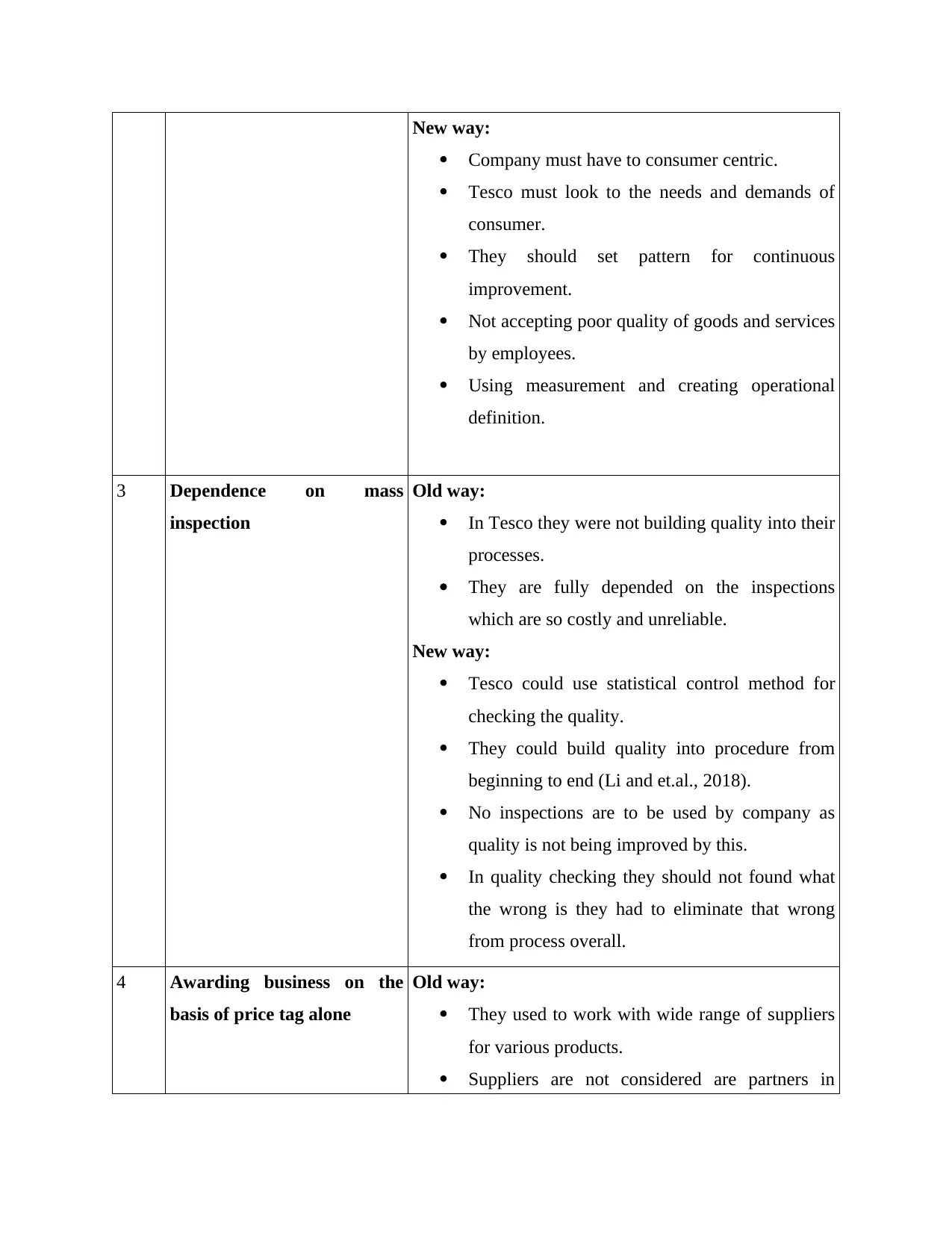
New way:
Company must have to consumer centric.
Tesco must look to the needs and demands of
consumer.
They should set pattern for continuous
improvement.
Not accepting poor quality of goods and services
by employees.
Using measurement and creating operational
definition.
3 Dependence on mass
inspection
Old way:
In Tesco they were not building quality into their
processes.
They are fully depended on the inspections
which are so costly and unreliable.
New way:
Tesco could use statistical control method for
checking the quality.
They could build quality into procedure from
beginning to end (Li and et.al., 2018).
No inspections are to be used by company as
quality is not being improved by this.
In quality checking they should not found what
the wrong is they had to eliminate that wrong
from process overall.
4 Awarding business on the
basis of price tag alone
Old way:
They used to work with wide range of suppliers
for various products.
Suppliers are not considered are partners in
Company must have to consumer centric.
Tesco must look to the needs and demands of
consumer.
They should set pattern for continuous
improvement.
Not accepting poor quality of goods and services
by employees.
Using measurement and creating operational
definition.
3 Dependence on mass
inspection
Old way:
In Tesco they were not building quality into their
processes.
They are fully depended on the inspections
which are so costly and unreliable.
New way:
Tesco could use statistical control method for
checking the quality.
They could build quality into procedure from
beginning to end (Li and et.al., 2018).
No inspections are to be used by company as
quality is not being improved by this.
In quality checking they should not found what
the wrong is they had to eliminate that wrong
from process overall.
4 Awarding business on the
basis of price tag alone
Old way:
They used to work with wide range of suppliers
for various products.
Suppliers are not considered are partners in
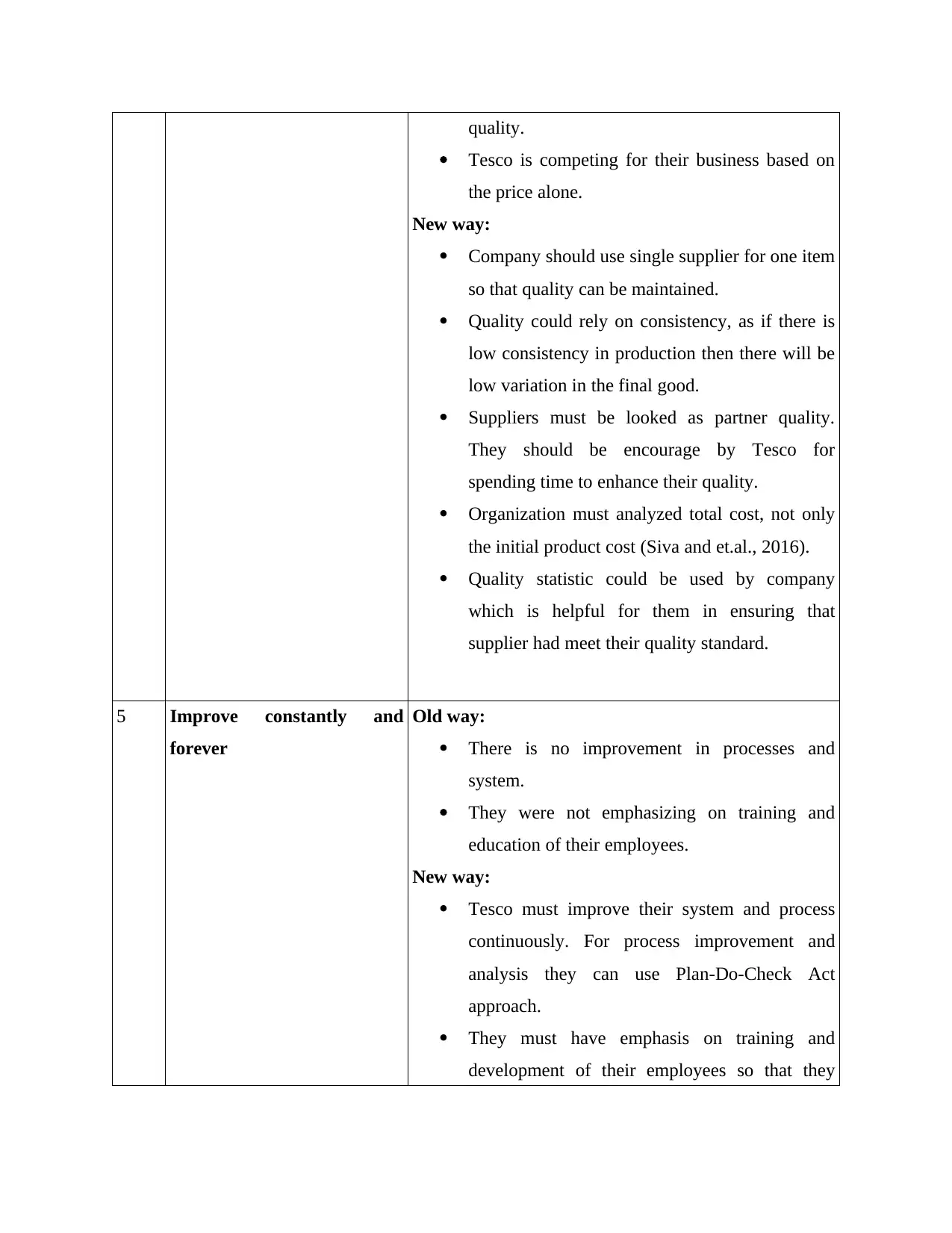
quality.
Tesco is competing for their business based on
the price alone.
New way:
Company should use single supplier for one item
so that quality can be maintained.
Quality could rely on consistency, as if there is
low consistency in production then there will be
low variation in the final good.
Suppliers must be looked as partner quality.
They should be encourage by Tesco for
spending time to enhance their quality.
Organization must analyzed total cost, not only
the initial product cost (Siva and et.al., 2016).
Quality statistic could be used by company
which is helpful for them in ensuring that
supplier had meet their quality standard.
5 Improve constantly and
forever
Old way:
There is no improvement in processes and
system.
They were not emphasizing on training and
education of their employees.
New way:
Tesco must improve their system and process
continuously. For process improvement and
analysis they can use Plan-Do-Check Act
approach.
They must have emphasis on training and
development of their employees so that they
Tesco is competing for their business based on
the price alone.
New way:
Company should use single supplier for one item
so that quality can be maintained.
Quality could rely on consistency, as if there is
low consistency in production then there will be
low variation in the final good.
Suppliers must be looked as partner quality.
They should be encourage by Tesco for
spending time to enhance their quality.
Organization must analyzed total cost, not only
the initial product cost (Siva and et.al., 2016).
Quality statistic could be used by company
which is helpful for them in ensuring that
supplier had meet their quality standard.
5 Improve constantly and
forever
Old way:
There is no improvement in processes and
system.
They were not emphasizing on training and
education of their employees.
New way:
Tesco must improve their system and process
continuously. For process improvement and
analysis they can use Plan-Do-Check Act
approach.
They must have emphasis on training and
development of their employees so that they
⊘ This is a preview!⊘
Do you want full access?
Subscribe today to unlock all pages.

Trusted by 1+ million students worldwide
1 out of 19
Related Documents
Your All-in-One AI-Powered Toolkit for Academic Success.
+13062052269
info@desklib.com
Available 24*7 on WhatsApp / Email
![[object Object]](/_next/static/media/star-bottom.7253800d.svg)
Unlock your academic potential
Copyright © 2020–2025 A2Z Services. All Rights Reserved. Developed and managed by ZUCOL.





